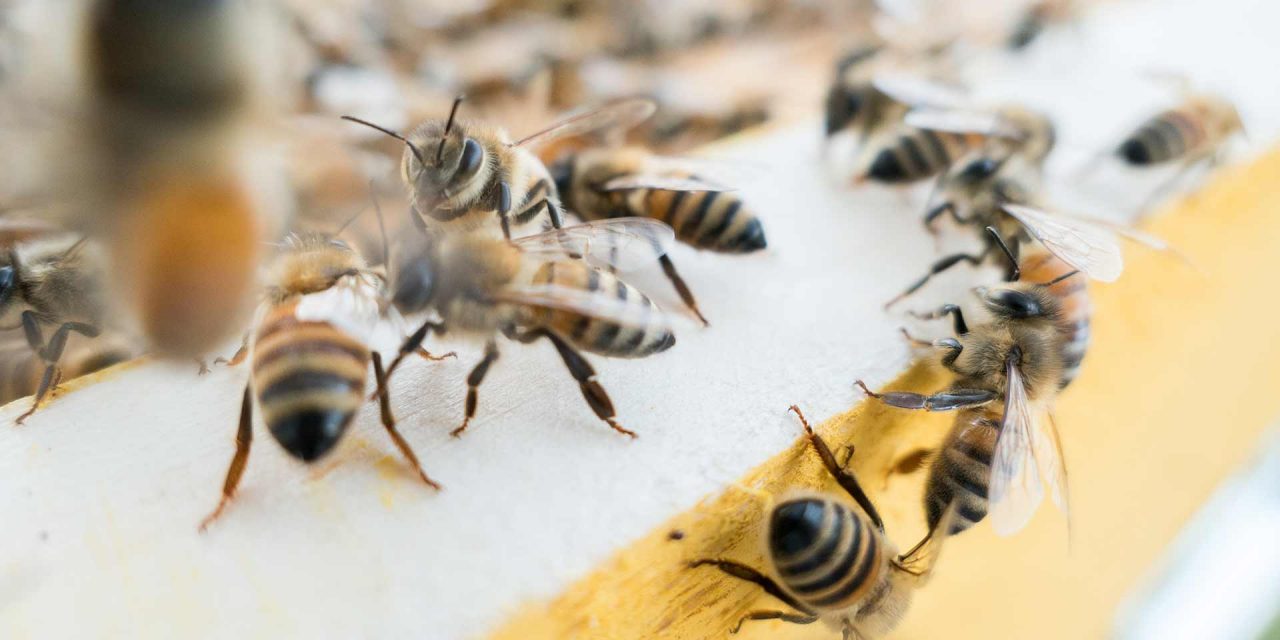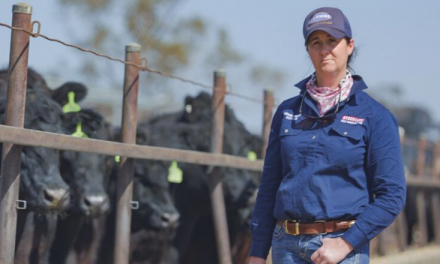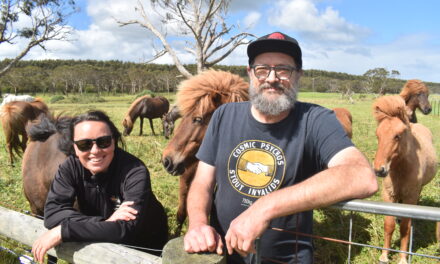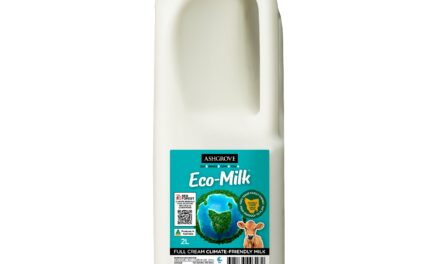Humans have helped themselves to the fruits of bee-labour for thousands of years.
The industrious insects collect nectar to make honey and pollen for protein. It takes three weeks for 300 bees to produce 450g of honey. They prefer to work close to home, but when pushed forage up to 1.5km away.
An average backyard hosts two or three hives comfortably. The rectangular wooden boxes contain removable frames on which bees build the hexagonal wax cells of their honeycomb.
Beekeepers often become blasé about the stinging foragers that can trigger an anaphylactic reaction in sensitive people. Nervous neighbours may not share such nonchalance. Jars of honey may sweeten neighbourly relations.
Locating hives is a balance between bees, beekeeper and neighbours. Bees need a dry, sunny position, preferably facing north-east.
Your neighbours won’t willingly share their swimming pool with your bees. Provide water in your own yard – complete with landing points such as rocks.
Try to handle your bees on a warm, sunny day, when the more aggressive bees are out working. Opening hives in the late afternoon allows the bees to calm down overnight.
Bees disperse by swarming; that is, the old queen flies off with half the workers. Those left behind rear a new queen. Swarms often alarm non-beekeepers. Tips to reduce swarming include re-queen regularly and/or take some honey from the brood nest.
When re-queening, the all-important factor for hobbyists is hive temperament. Commercial operators concentrate more on honey production and tendency to swarm. You can purchase queens or DIY (given good conditions and suitable drones).
Your hives need regular health checks. Other beekeepers won’t be happy if your diseased bees contaminate their hives – and neither will the law!
Beekeepers in Australia must be registered. Check with your local Department of Agriculture.
Bees fund farm work
Kevin Haskins and his wife Ruth own Hemmingstone, an 80ha block at Duri, south of Tamworth. They dabble in cattle, grain and hay, but the main game for Kevin is bees.
As an eager seven-year-old, he set up his first hive with his father’s help. One thing led to another: he now has 400 hives. About 20 years ago he traded bricklaying for commercial beekeeping.
“Bees fund the work I do on the farm,” the Duri born-and-raised farmer says.
Sourcing blossom and transporting bees occupies much of the 55-year-old’s time, and is a major business expense.
“Travel is one of the big costs … diesel, trucks for moving. We have the advantage over other cockies in that we can pick our enterprise up and take it to where the food is.”
Seasonal conditions dictate Kevin’s bee program. Ideally, it includes time in autumn/winter on stringybark.
“They come out of winter better if they’ve been on stringybark for the autumn. There’s lots of stringybark around here (Duri) – within 100 miles (160km). It’s just a matter of getting out and finding it … looking after the people whose country it is.”
The bees need to be in tip-top shape for the almond blossom at the end of winter.
“This year I took 300 hives down to Hillston. It’s 806km door-to-door. They’re on the almonds for 30 days.
“Something like 6000 hives went into the almond plantation this year. You’ve got to prepare bees for it every year. You can’t just take any old hives in there.
“After the almonds I like to get them on yellow box; there’s plenty of that around here. It’s cheap honey; doesn’t cost you too much to get it.
“If it rains we may get some lucerne, but it needs to rain every 10 days. Or there may be spotted gum down the coast. You’ve just got to go and have a look, but you get to be able to read it.
“It may get tough this summer as it hasn’t rained yet,” Kevin said when Small Farms spoke to him in late September.
“You have to know your country. You can deal with disease. If you keep bees in good condition, they stay healthier.
“The optimum is to move them when honey flow you’re on is nearly finished. Don’t let them sit there when there’s no food; they’re going to starve.
“An old bloke once said to me ‘If you look after them in the bad times, they’ll look after you in the good times.’ It’s pretty true. It’s like leaving sheep in a paddock with no feed. You can’t walk away and forget about them.
In spring and autumn, Kevin does maintenance checks: a general once-over, new combs and foundation in the bottom box, check the queen and check disease.
“Spring is when the EFB (European foulbrood) or AFB (American foulbrood) show up.”
When the top box is nearly full of honey, Kevin puts another box underneath. When the new box is half full, he robs the top box.
“If you’re on a honey flow you can take off honey twice a month, but don’t be too greedy,” he warns. “With it being so dry, it’s time to start leaving some honey behind. It’ll still be there next month and if it’s not, they needed it.
To extract honey, Kevin heats 180 boxes to 35℃ in a 6m container. After 24 hours he spins it out and into a 2000 litre tank.
“After the honey has settled, it runs into 1000 litre IBCs (intermediate bulk containers) and is transferred to the packer.”
Kevin’s advice for budding beekeepers?
“Do a course. Learn; understand how they work, what they need to thrive.”
Register hives to stop disease
Merv Mudford, an octogenarian from Binalong, near Canberra, also started beekeeping aged seven.
“Bees are fascinating. I can just sit and watch them.
“It’s always been a hobby, but it got out of hand: I had 300 hives. Then about 20 years ago a bushfire went through. Since then I’ve only had 20 (hives).
“I give most of the honey away.
“The main thing that worries me is people who don’t register their hives. It’s important, there’s a lot of disease.
“I check mine a couple of times a year. If they’re healthy they have good yellow cappings on their larvae.
Merv’s bees stay close by, feeding on yellow box and red gum, except when Binalong gardeners “borrow” a few.
His favourite honey is Scotch thistle. “It’s a really dark honey … doesn’t like to go candied.”
Merv is the “bee guru” of Binalong. Two of his protégés are Glenyse Ings and Cora Fairall.
“We’re real amateurs,” says Glenyse.
“But we want to learn,” Cora chimes in. “Where would we be without bees for the garden?
When the beekeeping gear of a late friend became available several years ago, the pair decided to go halves in it.
Cora’s hives, two doubles and a single, nestle among shrubs and vegetables on her double house block.
Glenyse and her husband Bob have one hive, but are ready for more.
“We’ve got clean hives in the shed ready to go,” says Glenyse.
“We extract honey once a year, then clean and scrub the hive and put in new frames.
“The first year we extracted in the kitchen. There was honey everywhere! When you cut the waxy cap off, it glistens. It’s beautiful.
“I like to sit out in the garden with a cup of tea watching them,” says Cora. “They’re fascinating.”
For more information, visit:








